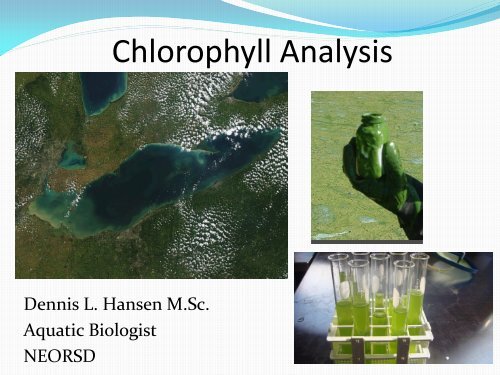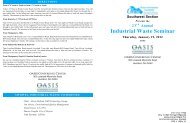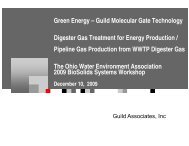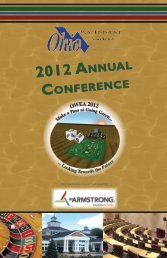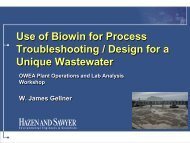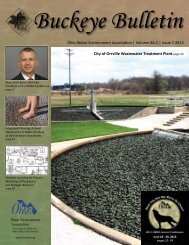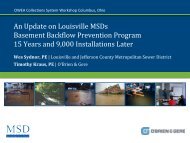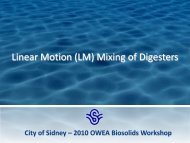Chlorophyll-A Analysis - Ohio Water Environment Association
Chlorophyll-A Analysis - Ohio Water Environment Association
Chlorophyll-A Analysis - Ohio Water Environment Association
- No tags were found...
Create successful ePaper yourself
Turn your PDF publications into a flip-book with our unique Google optimized e-Paper software.
<strong>Chlorophyll</strong> <strong>Analysis</strong>Dennis L. Hansen M.Sc.Aquatic BiologistNEORSD
Organization of Presentation•What is <strong>Chlorophyll</strong>?•Why Test For It?•Types of Algae•Detection Methods•Summary
Quick Definitions• <strong>Chlorophyll</strong> is a magnesium based green protein thatturns blue and red light into electron movement,which turns water and carbon dioxide into sugar.• There are a few types of chlorophyll: A, B, C, D & F.• Most labs focus on the most common type, A.• Phaeophytin is <strong>Chlorophyll</strong> without the magnesium.“Dead <strong>Chlorophyll</strong>”• If you want to stump your biologist, ask them fortheir phaeophytin numbers.
More Definitions• Bluegreen Algae (Cyanobacteria) are photosyntheticbacteria. Some produce toxins and some fix N2 from the air.• Diatoms are single celled algae that have a silica shell• Green algae are filamentous or flagellated algae• Dinoflagellates are single celled algae that cause redtides in marine environments
Lake Erie Has Algae• Is this Fish food or Fish poison• <strong>Chlorophyll</strong> A alone will not tell us
About The Algae: Diatoms• The Golden Algae-brown slippery rocks• Single celled and filamentous• Cell wall is made of 2 silica shells (like a pill box)• Store food as lipids, not starch• Great source of food for fish fry and zooplankton• Diatom presence is indicative of clean and clear lakes• Diatomaceous earth
About The Algae: Green Algae• Filamentous, single celled and flagellated• Store food as starch• Cell wall is made of cellulose, like land plants• Good source of food for fish fry and zooplankton• Green algae are found in all environments• Can cause severe algal blooms
About The Algae: Dinoflagellates• Single celled and flagellated• Two flagella, one around the waist and one on the end• Found in abundance in impaired waters.• Cell wall is made of rigid plates• Some are not photosynthetic• In marine environments, they make coral.• During a bloom, they cause red tide events
About The Algae: Cyanobacteria• Bluegreen algae, It’s photosynthetic bacteria• Some can fix N2• In waters with high phosphorus levels, N2 fixingcyanos will outcompete the green algae and diatoms• A few strains are toxic• Generally they are difficult to digest• Cell wall is made of peptidoglycan.• Nutrient sumplement
Toxic Algae Can Be a Public Hazard• We have all heard of fish kills caused bycyanobacteria• Every year, hunting dogs die from water thatcontained cyanotoxins.• In 2002, two boys in Madison, WI died afterswimming in, and ingesting water from a golf coursepond.
The presence of N fixing Heterocysts are2indicative of High phosphorus levels• High phosphorus levels will select for blue-green algaethat can fix nitrogen from the air and possibly be toxic• Anabaeana• Oscillatoria• Aphanizomenon
How Phosphorus Affects the Aquatic Food WebEdibleGreenAlgae &DiatomsLowPBlueGreensHighPMore FishFry&ZooplanktonLess FishFry &Plankton
Algal Blooms and Recreation•Non toxic algal blooms also promotebacteria growth, reduce water quality, anddiscourage beach use.
Why Measure <strong>Chlorophyll</strong> A?• Knowing the <strong>Chlorophyll</strong> A and phaeophytin levelscan give us a general idea about the health of oursystem.• There are two accepted techniques for measuring<strong>Chlorophyll</strong> A.
<strong>Chlorophyll</strong> Detection Techniques•Spectrophotometric Technique•Fluorometric Technique
Spectrophotometric Technique• For water samples with high levels chlorophyll.Red LightRed Light(~665nm) into the(~665nm) into theSampleDetectorhttp://toolboxes.flexiblelearning.net.au/demosites/series10/10_03/6lt/6lt3/htm/6lt3_1_2e.htm
Equipment for Spec Method• Spectrophotometer –• Tissue Grinder• Centrifuge• Dark room• 47 mm glass fiber filters• Forceps• Filtration manifold• Filtration funnels andbases• 15 mL conical tubes• Volumetric or autopipettesw/tips• Aluminum foil• Freezer (-30 Celcius)
Reagents and Standards• 90% acetone• DI water• Standards• Calibration• ICV – independentcalibration verification• CCV – continuingcalibration verification• CCB – continuingcalibration blank• Spinach• Standards PPM
Overview of theSpectrophotometric Method• US EPA method 150.1• The Spec method is used when chlorophyll levels are veryhigh.• Step 1: Collect water sample• Step 2: Filter known quantity of water onto a 47 mm glass fiberfilter• Put the filter in a known volume of an acetone solution andgrind the filter with a tissue grinder.• This releases the chloroplasts from the algae and filter
Overview of theSpectrophotometric Method• In a darkened room• Centrifuge the sample to settle the filter and debrisand aspirate the supernatant• Or just pour the solution through a paper filter• Deliver a portion of the chlorophyll solution into acuvette and place the sample into thespectrophotometer
Overview of theSpectrophotometric Method• Read the absorbance at 665 nm• Compare this value to your standard curve andaccount for the dilution factors.• The method to manually calculate theconcentration is in US EPA method 150.1• Most labs use the Fluorometric method
Fluorometric Technique• More sensitive than spectrophotometric techniquesfor low levels of chlorophyll.Red Light(685nm) into theDetectorBlue Light(440nm) into thesamplehttp://www.noc.soton.ac.uk/soes/teaching/courses/soes3018/2011/Group10/fluorometer.jpg
Equipment for LaboratoryFluorometric Method• Sample preparation is the same as the spec method• The fluorometer is more sensitive, so a very green samplemay need to be diluted.• Most fluorometers today will read chlorophyl out in mg/L.
Equipment for FieldFluorometric Method• Fluorometer attached to a sonde• Technician• The sonde will read out the concentration• This method is not reliable when algae physically floats in mats.
Summary• <strong>Chlorophyll</strong> A levels• Give us a snapshot of the algal biomass in the water• This correlates with the nutrient load• <strong>Chlorophyll</strong> A is only half of the story• The types of algae can tell us if our system is potentiallytoxic• If there is too much P or N• Not all strains of cyanobacteria are toxic• With minimal training, anyone that canmicroscopically analyze a sludge sample can analyzealgae in a water sample.


